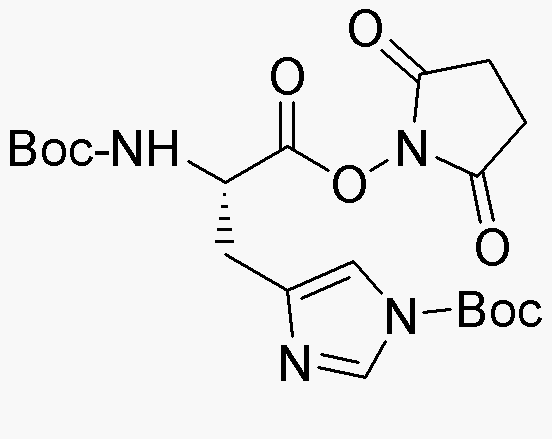Na,Nim-Bis-Boc-L-histidine N-hydroxysuccinimide ester is widely utilized in research focused on:
- Bioconjugation: This compound serves as an effective linker in bioconjugation processes, allowing researchers to attach biomolecules like proteins or antibodies to surfaces or other molecules, enhancing their functionality in drug delivery systems.
- Peptide Synthesis: It plays a crucial role in peptide synthesis, particularly in the formation of stable peptide bonds, which is essential for creating therapeutic peptides used in various medical applications.
- Drug Development: The compound is valuable in the pharmaceutical industry for developing new drugs, especially those targeting specific biological pathways, due to its ability to modify drug properties for improved efficacy.
- Diagnostics: In diagnostic applications, it can be used to label biomolecules for detection in assays, improving the sensitivity and specificity of tests used in clinical settings.
- Research in Cancer Therapy: This chemical is being explored in cancer research for its potential to create targeted therapies that can selectively deliver drugs to cancer cells, minimizing side effects on healthy tissues.
General Information
Properties
Safety and Regulations
Applications
Na,Nim-Bis-Boc-L-histidine N-hydroxysuccinimide ester is widely utilized in research focused on:
- Bioconjugation: This compound serves as an effective linker in bioconjugation processes, allowing researchers to attach biomolecules like proteins or antibodies to surfaces or other molecules, enhancing their functionality in drug delivery systems.
- Peptide Synthesis: It plays a crucial role in peptide synthesis, particularly in the formation of stable peptide bonds, which is essential for creating therapeutic peptides used in various medical applications.
- Drug Development: The compound is valuable in the pharmaceutical industry for developing new drugs, especially those targeting specific biological pathways, due to its ability to modify drug properties for improved efficacy.
- Diagnostics: In diagnostic applications, it can be used to label biomolecules for detection in assays, improving the sensitivity and specificity of tests used in clinical settings.
- Research in Cancer Therapy: This chemical is being explored in cancer research for its potential to create targeted therapies that can selectively deliver drugs to cancer cells, minimizing side effects on healthy tissues.
Documents
Safety Data Sheets (SDS)
The SDS provides comprehensive safety information on handling, storage, and disposal of the product.
Product Specification (PS)
The PS provides a comprehensive breakdown of the product’s properties, including chemical composition, physical state, purity, and storage requirements. It also details acceptable quality ranges and the product's intended applications.
Certificates of Analysis (COA)
Search for Certificates of Analysis (COA) by entering the products Lot Number. Lot and Batch Numbers can be found on a product’s label following the words ‘Lot’ or ‘Batch’.
*Catalog Number
*Lot Number
Certificates Of Origin (COO)
This COO confirms the country where the product was manufactured, and also details the materials and components used in it and whether it is derived from natural, synthetic, or other specific sources. This certificate may be required for customs, trade, and regulatory compliance.
*Catalog Number
*Lot Number
Safety Data Sheets (SDS)
The SDS provides comprehensive safety information on handling, storage, and disposal of the product.
DownloadProduct Specification (PS)
The PS provides a comprehensive breakdown of the product’s properties, including chemical composition, physical state, purity, and storage requirements. It also details acceptable quality ranges and the product's intended applications.
DownloadCertificates of Analysis (COA)
Search for Certificates of Analysis (COA) by entering the products Lot Number. Lot and Batch Numbers can be found on a product’s label following the words ‘Lot’ or ‘Batch’.
*Catalog Number
*Lot Number
Certificates Of Origin (COO)
This COO confirms the country where the product was manufactured, and also details the materials and components used in it and whether it is derived from natural, synthetic, or other specific sources. This certificate may be required for customs, trade, and regulatory compliance.


